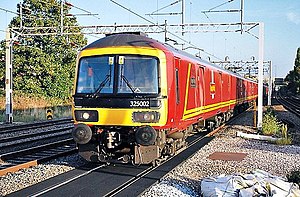British Rail Class 325
| British Rail Class 325 | |
|---|---|

Class 325s on the week-day Willesden to Shieldmuir Mail passing Harrow & Wealdstone in 2009
|
|
| In service | 1995 – Current |
| Manufacturer | ABB Derby |
| Family name | BR Second Generation (Mark 3) |
| Constructed | 1995 - 1996 |
| Number built | 16 trainsets |
| Number in service | 15 trainsets |
| Number scrapped | 1 trainsets |
| Formation | 4 cars per trainset: DTPMV+MPMV+TPMV+DTPMV |
| Operator(s) | DB Cargo UK |
| Specifications | |
| Car length | DTPMV - 19.83 m (65 ft 3⁄4 in) MPMV/TPMV - 19.92 m (65 ft 4 in) |
| Width | 2.82 m (9 ft 3 in) |
| Height | 3.78 m (12 ft 4 7⁄8 in) |
| Maximum speed | 100 mph (161 km/h) |
| Weight | Total - 138.5 t (136.3 long tons; 152.7 short tons) |
| Electric system(s) |
25 kV 50 Hz AC Overhead line 750 V DC 3rd rail |
| Current collection method |
Pantograph (AC) Contact shoe (DC) |
| Braking system(s) | Air |
| Track gauge | 1,435 mm (4 ft 8 1⁄2 in) standard gauge |
The British Rail Class 325 is a 4-car dual-voltage 25 kV alternating current (AC) or 750 V direct current (DC) electric multiple unit (EMU) train used for postal train services. While the Class 325 bears a resemblance to the Class 165 and 166 DMUs, they are based on the Class 319 EMU. The Class 325 was British Rail's newest unit to take over parcels workings on electrified lines.
In the early 1990s, the Parcels sector of British Rail were seeking a fleet of multiple units that would be more cost-effective to run than the locomotive hauled stock they were using. The initial proposal was to convert a number of redundant Class 307 units that were in the process of being withdrawn from passenger service into Class 300 parcels units. Owing to the age of these units however, it was subsequently decided to procure a fleet of new trains. These units, which were ordered in 1994, were initially given the TOPS classification Class 350, before being changed to Class 325.
The 16 units were built at ABB Derby between 1995 and 1996. They are very similar to Class 319 units, sharing the same traction equipment and body design, but are fitted with cabs of the same design as the ABB Networker family.
TOPS numbers are on the front of the cabs under the driver's window in a non-standard typeface, and the units were numbered 325001 - 325016. The units are fitted with large round oleo buffers, and have no gangways between carriages. They carry a livery of Royal Mail red, with two yellow stripes running along the lower bodyside before turning sharply backwards and pointing up towards the roof, black cab window surrounds and a full yellow warning panel. Each set is made up of four cars, with roller doors in place of sliding ones and no windows. Each car has two roller shutter sliding doors on each side and is designed to hold up to 12 tonnes. They have a pantograph to pick up power from the 25 kV AC overhead lines, and also a shoe to pick up power off the 750 V DC third rail. They cannot work in multiple with any other multiple unit stock, but are fitted with drop-head buck-eye coupling and can therefore be hauled by locomotives. The units were built in such a way that they could easily be converted for passenger use if no longer required for mail services.
...
Wikipedia
